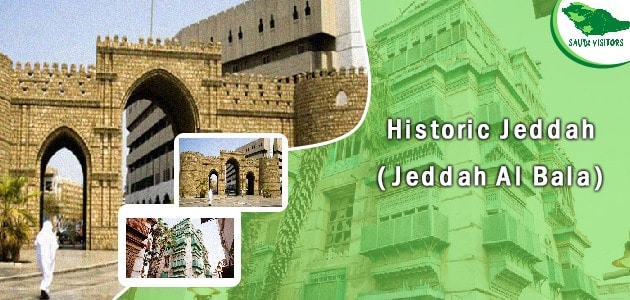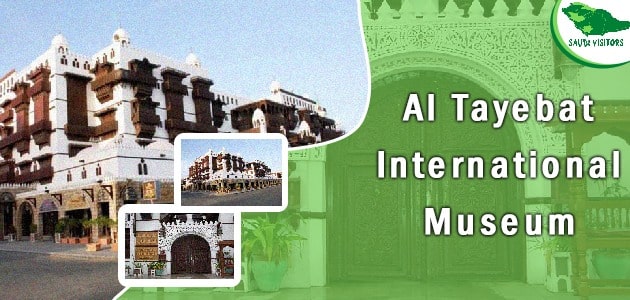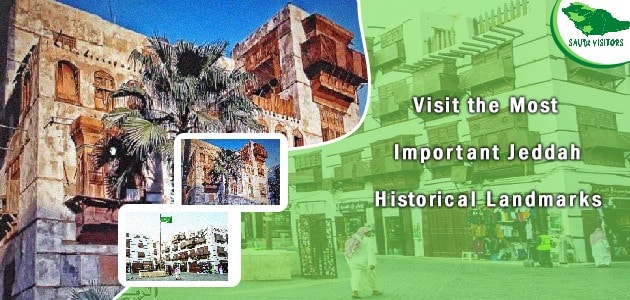Jeddah is one of the Kingdom of Saudi Arabia’s oldest cities, distinguished by its ancient Arab heritage. Jeddah is the gateway to the Hijaz, which dates back more than 3000 years and has seen many civilizations. Jeddah is also the gateway to Mecca, with King Abdulaziz International Airport serving pilgrims.
Many tourists visit Jeddah to learn about the Jeddah historical landmarks and to learn about ancient Saudi heritage. There are many historical monuments and tourist attractions in Jeddah that reflect Saudi Arabia’s history, civilization, and culture. Especially since Jeddah Historical Landmarks include mosques, palaces, museums, and old markets.
As a result, in this article, we will take you, dear reader, on a historical tour of Jeddah’s old neighborhoods to get to know the Jeddah Historical Landmarks, which is one of Saudi Arabia’s tourist attractions.
محتوى المقالة
The most prominent Jeddah historical landmarks
Historic Jeddah (Jeddah Al Balad)

The Historic District of Jeddah is one of the city’s oldest areas, and tourists from all over the world visit to see the historical monuments and the Saudi civilization. Many old architectural buildings in Jeddah’s historical area have been restored and renovated in recent years to become Jeddah’s historical landmarks.
In terms of the shape of the buildings and the tools used, as well as the inscriptions and the old style on the doors and windows in the region, the historical Jeddah area reflects Saudi civilization and ancient life in the Kingdom. Jeddah Al-Balad is one of the well-known Jeddah historical landmarks that many visitors visit.
The historic district of Jeddah is well-known for its wholesale shops. It is also well-known for the presence of the Mercaz Al-Omda, one of the most important centers in Jeddah’s historical district. It is a bustling market in Jeddah where you can find a wide variety of textiles and souvenirs. In addition, the markets in Jeddah’s historical city are constructed of mud bricks, which are old stone buildings.
Makkah Gate (Bab Makkah)
Makkah Gate, built-in 1979 AD, is the only gate connecting the two cities of Makkah and Jeddah. Makkah Gate is located outside of Jeddah on the road leading to Makkah and is used by pilgrims on their way to perform Hajj and Umrah. As a result, Makkah Gate is regarded one of the Jeddah Historical Landmarks.
Makkah Gate is well-known for its shops selling honey, dates, and dried fruits. There are also souvenirs. This gate is also the only remaining part of the massive wall that once surrounded Jeddah. It also serves as a parking lot for pilgrims and Umrah pilgrims traveling from Jeddah to Makkah Al-Mukarramah.
The gate’s exterior is in the old style, with stone walls and lighting that adds to its beauty at night.
Nassif House ( Beit Nassif )
Beit Nassif is one of the Jeddah Historical Landmarks, located in the historic Jeddah district in the city’s center and dating back to the nineteenth century. It is named for the Nassif family, who were once among the most prominent families in Jeddah. Beit Nassif is a historical archaeological building in the old style that witnessed many events and was used for a variety of purposes, including:
– It served as the residence of the ruler of Jeddah.
– It served as the residence of the ruler of Jeddah. Where King Abdulaziz used to meet with important figures to sign contracts.
– In the mid-1970s, it was also used as a public library, with over 16,000 books.
– In the 1990s, Beit Nassif became a gathering place for Jeddah’s wealthy and high social status.
– Beit Nassif is now a museum where tourists can learn about the history of Jeddah and the Saudi civilization.
Abdul Raouf Khalil Museum
Abdul Raouf Khalil Museum is one of the oldest Jeddah historical landmarks. It is among the most popular tourist places in Jeddah where tourists go to discover one of the Jeddah historical landmarks. The museum was established in 1996 and is regarded as one of the most well-known museums in Jeddah.
Within the Abdul Rauf Khalil Museum, there are numerous antiquities as well as important objects that tell the story of Jeddah in the past, from its earliest times to its accession to the Kingdom of Saudi Arabia after its unification. There are also remnants of various civilizations within the museum, such as the pre-Islamic period, the evidence from Islamic civilization, the remnants of the Ottoman time period, and many antiques from the modern age.
It is distinguished for its minimalist and elegant designs since it was built in an older style. It houses many kinds of historical relics through 18 galleries. Additionally, there is a mosque that is located within the museum. The museum has been divided into three major sections. The first section is dedicated to its Saudi heritage, while the second section focuses on the history and culture of the Ottoman Empire and the third section is devoted to the antiques from the modern age.
The King Abdul Aziz Hall and the Stones and Minerals Hall, which house a variety of environmental and historical landmarks, are two of the most well-known halls in this museum. If you visit Jeddah and the city of Jeddah, don’t miss the Abdul Raouf Khalil Museum, which is one of the most well-known Jeddah historical landmarks.
Al Tayebat International Museum for Science and Knowledge

Al-Tayebat Museum is thought to have been built in the Al-Faisaliah neighborhood of the famous city of Al-Tayebat in 1987AD. Al-Tayebat City has 12 buildings, including the Al-Tayebat Museum, which is one of the most important Jeddah historical landmarks. This museum, Al Tayebat Museum, is one of the most important museums in Jeddah, reflecting Saudi Arabia’s rich history as well as the history and culture of the Hejaz region.
On four floors, the Al-Tayebat Museum has 365 halls for displaying various antiquities. While some exhibits reflect Saudi heritage, others reflect overall Islamic heritage, there is an entire floor within the museum that showcases the city’s Islamic heritage. There are also artifacts from Islamic civilizations and scientific discoveries.
If you’re interested in Islamic civilizations and want to learn more about the history of the Kingdom of Saudi Arabia, we recommend visiting one of the most important Jeddah historical landmarks, The Al Tayebat Museum, to learn about the world’s past and cultures.
The admission fee to Al-Tayebat Museum is 80 Saudi Riyals or about 21 US dollars. Except on Friday, when it is closed, the museum is open from 8 a.m. to 12 p.m. and from 5 p.m. to 9 p.m.
Darat Safeya Bin zagr Museum, Jeddah
Darat Safiya Bin Zagr Museum is one of the Jeddah historical landmarks that has been recognized for its stunning engineering concept, as it was built in a unique manner, and the style of its façade resembles that of the town Mada’n Saleh. It is also one of Jeddah’s tourist attractions and well worth a visit to learn about Saudi history. Plastic art and ornaments from the old Islamic heritage are also on display at the museum.
The artist Safiya Binzagr has numerous works in the museum. This is why the museum was named after her. The museum is also divided into two floors. Safia’s paintings and ornaments depict Saudi history and ancient times on the first floor. The upper floor contains an accessible library with the most important artistic and cultural sources. This is why it is regarded as the best place for people who enjoy literature, culture, and history.
Museum of Home Arts in Jeddah
The Museum of Home Arts is located on Palestine Street in Jeddah, near the Conference Palace, and is one of Abdul Raouf Khalil’s Museums. The Museum of Home Arts is one of the most valuable Jeddah historical landmarks.
As a result, it is no surprise that the Museum of Fine Arts is regarded as one of the most important tourist destinations in Jeddah for engineering and design enthusiasts. Visitors to the museum can be inspired by their design ideas. Along with the collection of archeological models from ancient times, as well as ancient Hijaz clothing, particularly wedding gowns, furniture, and other tools.
The most well-known monuments in the Museum of Home Arts are fragments of the original Kaaba covers, as well as models of ancient mosques and councils. The museum is divided into two floors. Antiques, models, clothing, and other vintage items can be found on the ground floor. On the upper floor, salons, councils, and bedrooms are arranged in a creative and innovative manner to provide visitors with ideas for designing and arranging their own homes.
The famous streets of Jeddah
Because of its many landmarks and historic sites, Jeddah is considered a cultural and historical city. Aside from the presence of old-fashioned popular neighborhoods, these are among the top Jeddah historical landmarks. The old Jeddah streets were once part of the Jeddah wall, which was part of the Jeddah historical landmarks.
Haret Al-Sham, Al-Mazloum, Al-Yaman, Al-Bahr, and Hart Al-Million Child are some of the most well-known lanes in old Jeddah. Because of their geographical location or fame, the older Jeddah lanes were known by these names. For example, Harat Al-Sham was given this name because of its closeness to Bilad Al-Sham, and Al-Yaman was given this name because of its closeness to Yemen. The same name knows as Million Child’s street in the city because of the large number of children who live there.
The structures in Jeddah’s historical streets are made of mud, stone, and wood. They are built in the traditional style, as they were built in the previous era. Thus, as you travel through Jeddah’s neighborhoods and old neighborhoods, you will be able to discover the most significant Jeddah historical landmarks.
Jeddah’s Khuzam Palace Museum
In addition to the Jeddah historical landmarks mentioned in the preceding paragraphs, there is one Jeddah historical landmark that is distinguished by its architectural beauty and innovative designs. The Khuzam Palace Museum, located in the Al-Nazla neighborhood in Jeddah’s south, is one of the city’s tourist attractions and one of the Jeddah historical landmarks that must be visited to learn about history and civilization.
The Khuzam Palace Museum is distinguished from other museums in Jeddah by being the first to be constructed of cement and iron, whereas all other museums are constructed of mud and stones. The museum was finished in 1932. It was also built on the orders of King Abdulaziz Al Saud, the founder of the Kingdom of Saudi Arabia, during his stay at Nassif House.
Many artifacts from the Kingdom’s history, civilizations, and antiquity can be found in the museum. Where there are artifacts from the Stone Age. So, while in Jeddah, don’t forget to stop by the Khuzam Palace Museum to learn about the Kingdom’s history and admire the ancient historical monuments.
Conclusion
In this article, we discussed the Jeddah historical landmarks as well as the religious and cultural status of the city of Jeddah, which made it one of the distinctive tourist destinations that every traveler should add to their list. In addition, the city of Jeddah is regarded as one of the best tourist attractions in Saudi Arabia for those interested in history, culture, and civilization.
In addition to historical and, heritage monuments in Jeddah, the city of Jeddah has many modern tourist attractions that were established and developed recently to develop the tourism sector in Saudi Arabia in accordance with the Kingdom’s vision 2030. Here are the most recent 6 tourist attractions in Jeddah that you can visit and enjoy.

